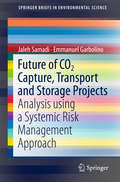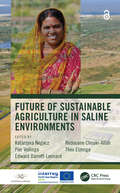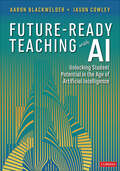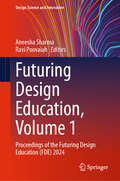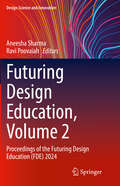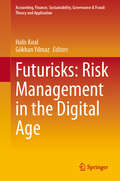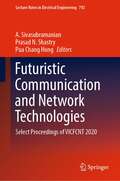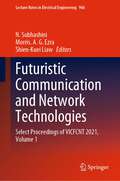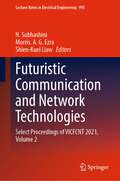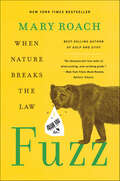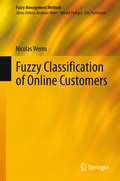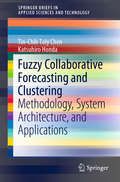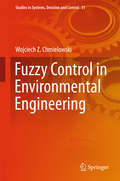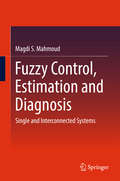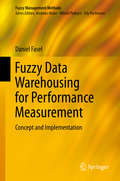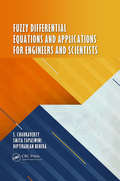- Table View
- List View
Future of CO2 Capture, Transport and Storage Projects: Analysis Using A Systemic Risk Management Approach (SpringerBriefs in Environmental Science)
by Emmanuel Garbolino Jaleh SamadiThis book presents a summary of a three-year research project on risk management for the Capture, Transport and Storage of CO2 (CTSC), offering an in-depth study on complex sociotechnical systems and systemic modeling. Approaching CTSC as a complex sociotechnical system, this book proposes systemic modeling as a decision-making aid. It offers a means of decision-making for the development of CTSC projects in the real-world context, where the future of the technology is uncertain. Risk management is considered as a means of control that can provide a control structure for the whole system.The risks associated with CTSC are not exclusively technical in nature; CTSC also faces a number of further uncertainties, from development to commercial scales.A major question concerning CTSC at the current scale of development is: "What are the factors explaining the success or failure of CTSC projects in different contexts?" In order to answer this question, the book proposes a systemic risk management framework based on the system dynamics and STAMP (Systems-Theoretic Accident Model and Processes) concepts.
Future of Management: Proceedings of ICMR-2024
by Koustubh Kanti RayIn response to unparalleled challenges and opportunities, the scope of management is undergoing a profound transformation. Organisations must adapt and innovate in order to flourish in an era characterised by rapid technological advancements, climate change, shifting demographics, and evolving social norms. The three pillars of modern management— sustainability, diversity, and inclusivity—reflect a comprehensive approach that prioritises the well-being of people and the planet over short-term profits and reflects a commitment to social responsibility. In the current era of management, sustainability has emerged as a critical issue. Organisations must incorporate ethical considerations into their decision-making processes, reduce their carbon footprints, and implement eco-conscious practices as the effects of climate change become more severe. According to Paul Polman, the former CEO of Unilever, “Sustainability is not a charity; it is a business case.”
Future of Sustainable Agriculture in Saline Environments
by Katarzyna NegaczFood production on present and future saline soils deserves the world’s attention particularly because food security is a pressing issue, millions of hectares of degraded soils are available worldwide, freshwater is becoming increasingly scarce, and the global sea-level rise threatens food production in fertile coastal lowlands. Future of Sustainable Agriculture in Saline Environments aims to showcase the global potential of saline agriculture. The book covers the essential topics, such as policy and awareness, soil management, future crops, and genetic developments, all supplemented by case studies that show how this knowledge has been applied. It offers an overview of current research themes and practical cases focused on enhancing food production on saline lands. FEATURES Describes the critical role of the revitalization of salt-degraded lands in achieving sustainability in agriculture on a global scale Discusses practical solutions toward using drylands and delta areas threatened by salinity for sustainable food production Presents strategies for adaptation to climate change and sea-level rise through food production under saline conditions Addresses the diverse aspects of crop salt tolerance and microbiological associations Highlights the complex problem of salinity and waterlogging and safer management of poor-quality water, supplemented by case studies A PDF version of this book is available for free in Open Access at www.taylorfrancis.com. It has been made available under a Creative Commons Attribution-Non Commercial-No Derivatives 4.0 license.
Future-Proofing Fuel Cells: Critical Raw Material Governance in Sustainable Energy
by Robert Lindner Martin David Stephen M. Lyth George F. HarringtonAs the world accelerates towards a renewable energy transition, the demand for critical raw materials (CRMs) for energy generation, conversion, and storage technologies is seeing a drastic increase. Such materials are not only subject to limited supply and extreme price volatility but can also represent serious burdens to the environment, to human health, and also to socio-political systems. Taking an interdisciplinary perspective, this book provides a novel perspective on the discussion about material dependencies of energy technologies. It examines CRMs use in fuel cells, an emerging energy conversion technology, and discusses governance strategies for early-stage fuel cell development to predict and avoid potential issues. This will be an invaluable resource for researchers in energy studies, engineering, sociology and political science as well as those with a general interest in this field looking for an accessible overview.
Future-Ready Teaching With AI: Unlocking Student Potential in the Age of Artificial Intelligence (Corwin Teaching Essentials)
by Aaron Blackwelder Jason CowleyPrepare your students for a future where AI literacy is crucial Artificial intelligence (AI) is here and seems on the brink of transforming education. As teachers, we know that AI will not diminish the need for students to learn essential skills. It will, however, change how we teach and will require us to develop new skill sets for instruction and assessment. Teachers have a new opportunity—to embrace future-ready instruction that prepares students to engage in a world that expects them to be AI literate. In Future-Ready Teaching With AI: Unlocking Student Potential in the Age of Artificial Intelligence, authors Aaron Blackwelder and Jason Cowley explore the integration of AI in the classroom and its potential to revolutionize teaching. Much more than simply a book about using AI tools, this rich resource aims to help teachers raise rigor, increase engagement, and promote more meaningful learning opportunities in their classrooms as they embrace the future of teaching and learning. Offering evergreen principles and strategies to help educators navigate the age of AI, this book Encourages critical thinking about the ethical use of AI to foster conversations with students Highlights various practical tools that can help teachers meet diverse student learning needs as well as create AI-proof assignments Includes chapter vignettes, sample AI prompts, activities, reflective questions, and links to online resources to support teachers′ work in the classroom Examines how to leverage AI to streamline rudimentary tasks such as lesson planning, assessment, and differentiation, allowing teachers to focus on building relationships, providing feedback, and personalizing learning for their students Written by two secondary teachers, this book is an essential resource for K–12 teachers and administrators looking to move beyond the basics of using AI. By equipping educators to become leaders in this transformation, Future-Ready Teaching With AI demonstrates how to harness the power of AI to help every student thrive.
Future-Ready Teaching With AI: Unlocking Student Potential in the Age of Artificial Intelligence (Corwin Teaching Essentials)
by Aaron Blackwelder Jason CowleyPrepare your students for a future where AI literacy is crucial Artificial intelligence (AI) is here and seems on the brink of transforming education. As teachers, we know that AI will not diminish the need for students to learn essential skills. It will, however, change how we teach and will require us to develop new skill sets for instruction and assessment. Teachers have a new opportunity—to embrace future-ready instruction that prepares students to engage in a world that expects them to be AI literate. In Future-Ready Teaching With AI: Unlocking Student Potential in the Age of Artificial Intelligence, authors Aaron Blackwelder and Jason Cowley explore the integration of AI in the classroom and its potential to revolutionize teaching. Much more than simply a book about using AI tools, this rich resource aims to help teachers raise rigor, increase engagement, and promote more meaningful learning opportunities in their classrooms as they embrace the future of teaching and learning. Offering evergreen principles and strategies to help educators navigate the age of AI, this book Encourages critical thinking about the ethical use of AI to foster conversations with students Highlights various practical tools that can help teachers meet diverse student learning needs as well as create AI-proof assignments Includes chapter vignettes, sample AI prompts, activities, reflective questions, and links to online resources to support teachers′ work in the classroom Examines how to leverage AI to streamline rudimentary tasks such as lesson planning, assessment, and differentiation, allowing teachers to focus on building relationships, providing feedback, and personalizing learning for their students Written by two secondary teachers, this book is an essential resource for K–12 teachers and administrators looking to move beyond the basics of using AI. By equipping educators to become leaders in this transformation, Future-Ready Teaching With AI demonstrates how to harness the power of AI to help every student thrive.
Futuring Design Education, Volume 1: Proceedings of the Futuring Design Education (FDE) 2024 (Design Science and Innovation)
by Ravi Poovaiah Aneesha SharmaThis book presents select proceedings of the two-day conference titled Futuring Design Education (FDE 2024), and it examines the transformation of design knowledge, the evolving spaces of learning, and the ecosystems of teaching and learning. The topics covered include the pedagogical model of design education, the experiments, and technological advances that impact design education. The book also discusses the roles and challenges of learning spaces, remote learning in digital spaces, and synchronous and asynchronous learning tools. The book will also look at the social contexts in design pedagogy, cultural affiliations and alignments and will allude to any new learning frameworks for design education. The book can be a valuable reference for design educators, design researchers, and professionals interested in design education.
Futuring Design Education, Volume 2: Proceedings of the Futuring Design Education (FDE) 2024 (Design Science and Innovation)
by Ravi Poovaiah Aneesha SharmaThis book presents select proceedings of the two-day conference titled Futuring Design Education (FDE 2024), and it examines the transformation of design knowledge, the evolving spaces of learning, and the ecosystems of teaching and learning. The topics covered include the pedagogical model of design education, the experiments, and technological advances that impact design education. The book also discusses the roles and challenges of learning spaces, remote learning in digital spaces, and synchronous and asynchronous learning tools. The book will also look at the social contexts in design pedagogy, cultural affiliations and alignments and will allude to any new learning frameworks for design education. The book can be a valuable reference for design educators, design researchers, and professionals interested in design education.
Futurisks: Risk Management in the Digital Age (Accounting, Finance, Sustainability, Governance & Fraud: Theory and Application)
by Halis Kıral Gökhan YılmazThis book explores the profound impact of digital transformation on enterprise risk management. It highlights the shifting dynamics of supply and demand influenced by technological advancements, evolving customer preferences, geopolitical tensions, and regulatory developments. Beyond building digital infrastructure, digital transformation requires organizations to rethink strategic decisions, business processes, and the legal and ethical frameworks governing operations. The book identifies critical risk areas amplified by digital transformation, including cybersecurity, data privacy, compliance, labor, third-party dependencies, business continuity, environmental sustainability, and regulatory challenges. The book underscores the need for organizations to move beyond superficial digital updates and adopt transformative approaches to business models, processes, and structures. It offers actionable strategies for leaders to navigate the complexities of rapid technological change and turn emerging risks into opportunities.
Futuristic Communication and Network Technologies: Select Proceedings of VICFCNT 2020 (Lecture Notes in Electrical Engineering #792)
by A. Sivasubramanian Prasad N. Shastry Pua Chang HongThis book presents select proceedings of the International Conference on Futuristic Communication and Network Technologies (CFCNT 2020) conducted at Vellore Institute of Technology, Chennai. It covers various domains in communication engineering and networking technologies. This volume comprises of recent research in areas like optical communication, optical networks, optics and optical computing, emerging trends in photonics, MEMS and sensors, active and passive RF components and devices, antenna systems and applications, RF devices and antennas for microwave emerging technologies, wireless communication for future networks, signal and image processing, machine learning/AI for networks, internet of intelligent things, network security and blockchain technologies. This book will be useful for researchers, professionals, and engineers working in the core areas of electronics and communication.
Futuristic Communication and Network Technologies: Select Proceedings of VICFCNT 2021, Volume 1 (Lecture Notes in Electrical Engineering #966)
by Shien-Kuei Liaw N. Subhashini Morris. A. G. EzraThis book presents select proceedings of the Virtual International Conference on Futuristic Communication and Network Technologies (VICFCNT 2021). It covers various domains in communication engineering and networking technologies. This volume comprises recent research in areas like cyber-physical systems, acoustics, speech & video signal processing, and IoT. This book is a collated work of academicians, researchers, and industry personnel from the international arena. This book will be useful for researchers, professionals, and engineers working in the core areas of electronics and communication.
Futuristic Communication and Network Technologies: Select Proceedings of VICFCNT 2021, Volume 2 (Lecture Notes in Electrical Engineering #995)
by Shien-Kuei Liaw N. Subhashini Morris. A. G. EzraThis book presents select proceedings of the Virtual International Conference on Futuristic Communication and Network Technologies (VICFCNT 2021). It covers various domains in communication engineering and networking technologies. This volume comprises recent research in areas like cyber-physical systems, acoustics, speech & video signal Processing, and the Internet of Things. This book is a collated work of academicians, researchers, and industry personnel from the international arena. This book will be useful for researchers, professionals, and engineers working in the core areas of electronics and communication.
Futuristic Sustainable Energy & Technology: Proceedings of the International Conference on Futuristic Sustainable Energy &Technology (ICFSE, 2021), 19-20 September, 2021
by Rajesh Singh; Anita Gehlot; P.S. Ranjit; Dolly SharmaFuturistic Sustainable Energy and Technology provides a structured overview of the concept of Futuristic Sustainable Energy and Technology. It also explores the promotion of the sustainable development of renewable energy from the perspectives of technology, modelling, application, sustainability and policy. This book is dedicated to the advancement of energy efficiency to mitigate consumption, ensure and replenish, expand and reuse elective energy supplies, and to replicate the damage caused by previous energy initiatives. This book has offered a large stage of experimentation for practitioners, experts, researchers and teachers to incorporate and analyze their latest developments, as well as the trends and difficulties encountered and the ongoing evolution of the stage in these areas.
Fuzz: When Nature Breaks the Law
by Mary RoachAn Instant New York Times Bestseller #1 Los Angeles Times Bestseller #1 Indie Hardcover Nonfiction Bestseller A Publishers Weekly Best Nonfiction Book of 2021 Longlisted for the 2022 Andrew Carnegie Medal for Excellence in Nonfiction Join "America’s funniest science writer" (Peter Carlson, Washington Post), Mary Roach, on an irresistible investigation into the unpredictable world where wildlife and humans meet.What’s to be done about a jaywalking moose? A bear caught breaking and entering? A murderous tree? Three hundred years ago, animals that broke the law would be assigned legal representation and put on trial. These days, as New York Times best-selling author Mary Roach discovers, the answers are best found not in jurisprudence but in science: the curious science of human-wildlife conflict, a discipline at the crossroads of human behavior and wildlife biology.Roach tags along with animal-attack forensics investigators, human-elephant conflict specialists, bear managers, and "danger tree" faller blasters. Intrepid as ever, she travels from leopard-terrorized hamlets in the Indian Himalaya to St. Peter’s Square in the early hours before the pope arrives for Easter Mass, when vandal gulls swoop in to destroy the elaborate floral display. She taste-tests rat bait, learns how to install a vulture effigy, and gets mugged by a macaque.Combining little-known forensic science and conservation genetics with a motley cast of laser scarecrows, langur impersonators, and trespassing squirrels, Roach reveals as much about humanity as about nature’s lawbreakers. When it comes to "problem" wildlife, she finds, humans are more often the problem—and the solution. Fascinating, witty, and humane, Fuzz offers hope for compassionate coexistence in our ever-expanding human habitat.
Fuzziness in Information Systems
by Miroslav HudecThis book is an essential contribution to the description of fuzziness in information systems. Usually users want to retrieve data or summarized information from a database and are interested in classifying it or building rule-based systems on it. But they are often not aware of the nature of this data and/or are unable to determine clear search criteria. The book examines theoretical and practical approaches to fuzziness in information systems based on statistical data related to territorial units. Chapter 1 discusses the theory of fuzzy sets and fuzzy logic to enable readers to understand the information presented in the book. Chapter 2 is devoted to flexible queries and includes issues like constructing fuzzy sets for query conditions, and aggregation operators for commutative and non-commutative conditions, while Chapter 3 focuses on linguistic summaries. Chapter 4 presents fuzzy logic control architecture adjusted specifically for the aims of business and governmental agencies, and shows fuzzy rules and procedures for solving inference tasks. Chapter 5 covers the fuzzification of classical relational databases with an emphasis on storing fuzzy data in classical relational databases in such a way that existing data and normal forms are not affected. This book also examines practical aspects of user-friendly interfaces for storing, updating, querying and summarizing. Lastly, Chapter 6 briefly discusses possible integration of fuzzy queries, summarization and inference related to crisp and fuzzy databases. The main target audience of the book is researchers and students working in the fields of data analysis, database design and business intelligence. As it does not go too deeply into the foundation and mathematical theory of fuzzy logic and relational algebra, it is also of interest to advanced professionals developing tailored applications based on fuzzy data.
Fuzzy Business Models and ESG Risk: Offering a Sustainable Perspective on Companies and Financial Institutions (Palgrave Studies in Impact Finance)
by Magdalena ZioloThis book discusses fuzzy business models and focuses on using fuzzy logic in business processes from the perspective of financial institutions when integrating ESG factors and risk. Developing and examining sustainable business models requires an appropriate methodology that would consider the specificity of business models because the measurement of this phenomenon is often based on values from specific ranges and requires a fuzzy approach. According to the law, regulations, and recommendations, financial institutions and businesses must incorporate Environmental Social Governance factors and ESG risk in their decision-making process. Sustainable financial institutions include ESG risk in their risk management system, strategies, and policies. As a result, they hope to mitigate ESG risk and create sustainable value in their business models with an impact on sustainable value creation. This book discusses this phenomenon in detail.One of the first on the market to address the issue of fuzzy business models, the book also deals comprehensively with the fuzzy logic in modeling business processes, decision-making processes, and business models using examples from financial institutions, and will be of interest to researchers, professors, and students of sustainable finance, banking, and sustainable development alongside corporate sustainability.
Fuzzy Classification of Online Customers
by Nicolas WerroThis book introduces a fuzzy classification approach, which combines relational databases with fuzzy logic for more effective and powerful customer relationship management (CRM). It shows the benefits of a fuzzy classification in contrast to the traditional sharp evaluation of customers for the acquisition, retention and recovery of customers in online shops. The book starts with a presentation of the basic concepts, fuzzy set theory and the combination of relational databases and fuzzy classification. In its second part, it focuses on the customer perspective, detailing the central concepts of CRM, its theoretical constructs and aspects of analytical, operational and collaborative CRM. It juxtaposes fuzzy and sharp customer classes and shows the implications for customer positioning, mass customization, personalization, customer assessment and controlling. Finally, the book presents the application and implementation of the concepts in online shops. A detailed case study presents the application and a separate chapter introduces the fuzzy Classification Query Language (fCQL) toolkit for implementing these concepts. In its appendix the book lists the fuzzy set operators and the query language's grammar.
Fuzzy Collaborative Forecasting and Clustering: Methodology, System Architecture, and Applications (SpringerBriefs in Applied Sciences and Technology)
by Tin-Chih Toly Chen Katsuhiro HondaThis book introduces the basic concepts of fuzzy collaborative forecasting and clustering, including its methodology, system architecture, and applications. It demonstrates how dealing with disparate data sources is becoming more and more popular due to the increasing spread of internet applications. The book proposes the concepts of collaborative computing intelligence and collaborative fuzzy modeling, and establishes several so-called fuzzy collaborative systems. It shows how technical constraints, security issues, and privacy considerations often limit access to some sources. This book is a valuable source of information for postgraduates, researchers and fuzzy control system developers, as it presents a very effective fuzzy approach that can deal with disparate data sources, big data, and multiple expert decision making.
Fuzzy Control in Environmental Engineering
by Wojciech Z. ChmielowskiThis book is intended for engineers, technicians and people who plan to use fuzzy control in more or less developed and advanced control systems for manufacturing processes, or directly for executive equipment. Assuming that the reader possesses elementary knowledge regarding fuzzy sets and fuzzy control, by way of a reminder, the first parts of the book contain a reminder of the theoretical foundations as well as a description of the tools to be found in the Matlab/Simulink environment in the form of a toolbox. The major part of the book presents applications for fuzzy controllers in control systems for various manufacturing and engineering processes. It presents seven processes and problems which have been programmed using fuzzy controllers. The issues discussed concern the field of Environmental Engineering. Examples are the control of a flood wave passing through a hypothetical, and then the real Dobczyce reservoir in the Raba River, which is located in the upper Vistula River basin in Southern Poland, the control and water management in a cascade of reservoirs, a broadly defined combustion process model, modern water heating systems and many other.
Fuzzy Control, Estimation and Diagnosis
by Magdi S. MahmoudThis textbook explains the principles of fuzzy systems in some depth together with information useful in realizing them within computational processes. The various algorithms and example problem solutions are a well-balanced and pertinent aid for research projects, laboratory work and graduate study. In addition to its worked examples, the book also uses end-of-chapter exercises as an instructional aid with a downloadable solutions manual available to instructors. The content of the book is developed and extended from material taught for four years in the author's classes. The text provides a broad overview of fuzzy control, estimation and fault diagnosis. It ranges over various classes of target system and modes of control and then turns to filtering, stabilization, and fault detection and diagnosis. Applications, simulation tools and an appendix on algebraic inequalities complete a unified approach to the analysis of single and interconnected fuzzy systems. Fuzzy Control, Estimation and Fault Detection is a guide for final-year undergraduate and graduate students of electrical and mechanical engineering, computer science and information technology, and will also be instructive for professionals in the information technology sector.
Fuzzy Data Warehousing for Performance Measurement
by Daniel FaselThe numeric values retrieved from a data warehouse may be difficult for business users to interpret, and may even be interpreted incorrectly. Therefore, in order to better understand numeric values, business users may require an interpretation in meaningful, non-numeric terms. However, if the transition between non-numeric terms is crisp, true values cannot be measured and a smooth transition between classes may no longer be possible. This book addresses this problem by presenting a fuzzy classification-based approach for a data warehouses. Moreover, it introduces a modeling approach for fuzzy data warehouses that makes it possible to integrate fuzzy linguistic variables in a meta-table structure. The essence of this structure is that fuzzy concepts can be integrated into the dimensions and facts of an existing classical data warehouse without affecting its core. This allows a simultaneous analysis, both fuzzy and crisp. A case study of a movie rental company underlines and exemplifies the proposed approach.
Fuzzy Differential Equations and Applications for Engineers and Scientists
by Smita Tapaswini Diptiranjan Behera S. ChakravertyDifferential equations play a vital role in the modeling of physical and engineering problems, such as those in solid and fluid mechanics, viscoelasticity, biology, physics, and many other areas. In general, the parameters, variables and initial conditions within a model are considered as being defined exactly. In reality there may be only vague, imprecise or incomplete information about the variables and parameters available. This can result from errors in measurement, observation, or experimental data; application of different operating conditions; or maintenance induced errors. To overcome uncertainties or lack of precision, one can use a fuzzy environment in parameters, variables and initial conditions in place of exact (fixed) ones, by turning general differential equations into Fuzzy Differential Equations ("FDEs"). In real applications it can be complicated to obtain exact solution of fuzzy differential equations due to complexities in fuzzy arithmetic, creating the need for use of reliable and efficient numerical techniques in the solution of fuzzy differential equations. These include fuzzy ordinary and partial, fuzzy linear and nonlinear, and fuzzy arbitrary order differential equations. This unique work?provides a new direction for the reader in the use of basic concepts of fuzzy differential equations, solutions and its applications. It can serve as an essential reference work for students, scholars, practitioners, researchers and academicians in engineering and science who need to model uncertain physical problems.
Fuzzy Differential Equations in Various Approaches
by Luciana Takata Gomes Laécio Carvalho de Barros Barnabas BedeThis book may be used as reference for graduate students interested in fuzzy differential equations and researchers working in fuzzy sets and systems, dynamical systems, uncertainty analysis, and applications of uncertain dynamical systems. Beginning with a historical overview and introduction to fundamental notions of fuzzy sets, including different possibilities of fuzzy differentiation and metric spaces, this book moves on to an overview of fuzzy calculus thorough exposition and comparison of different approaches. Innovative theories of fuzzy calculus and fuzzy differential equations using fuzzy bunches of functions are introduced and explored. Launching with a brief review of essential theories, this book investigates both well-known and novel approaches in this field; such as the Hukuhara differentiability and its generalizations as well as differential inclusions and Zadeh's extension. Through a unique analysis, results of all these theories are examined and compared.
Fuzzy Logic and Hydrological Modeling
by Zekai SenThe hydrological sciences typically present grey or fuzzy information, making them quite messy and a choice challenge for fuzzy logic application. Providing readers with the first book to cover fuzzy logic modeling as it relates to water science, the author takes an approach that incorporates verbal expert views and other parameters that allow
Fuzzy Management: A Fuzzy Grassroots Ontology For Online Reputation Management (essentials)
by Edy Portmann Andreas MeierAndreas Meier und Edy Portmann verwenden in diesem essential über Fuzzy Management die unscharfe Logik zur Lösung betriebswirtschaftlicher Probleme in der digitalen Wirtschaft. Die unscharfe Logik erweitert die klassische Logik mit den beiden Werten „wahr“ und „falsch“ und führt zu differenzierteren Beurteilungen. Neben Portfolio Management, Performance Measurement, Service Level Engineering und Reputationsmanagement wird die Business Intelligence mit weichen Faktoren angereichert, um den Entscheidungsprozess zu verbessern.
